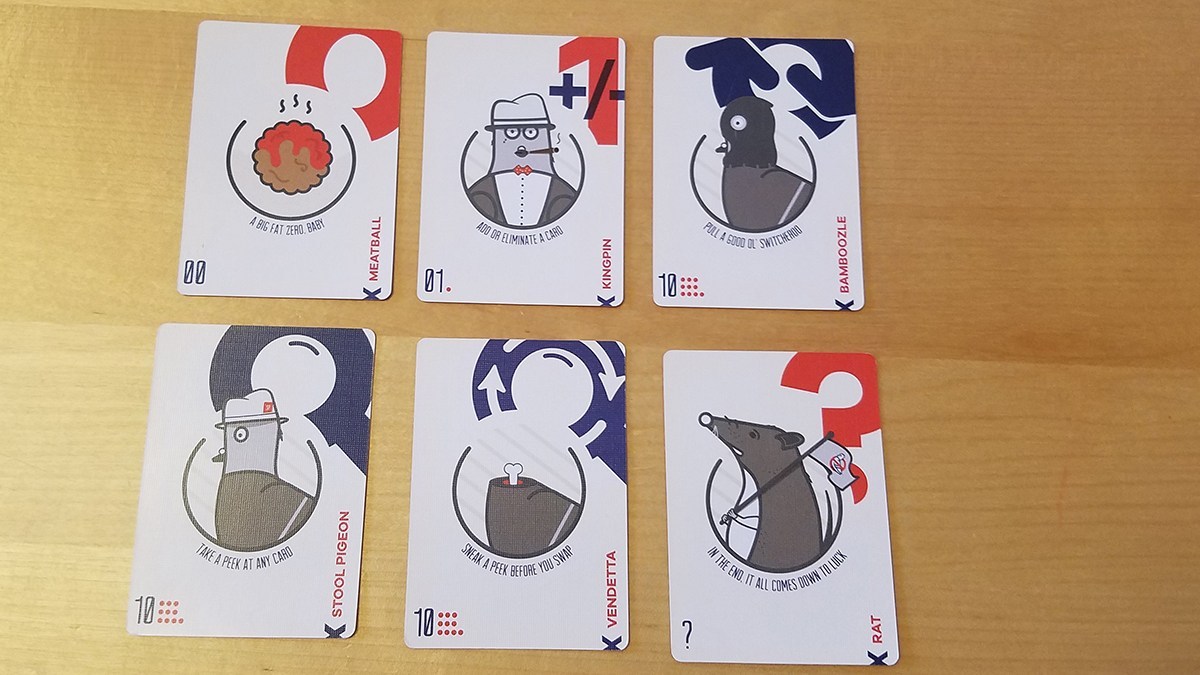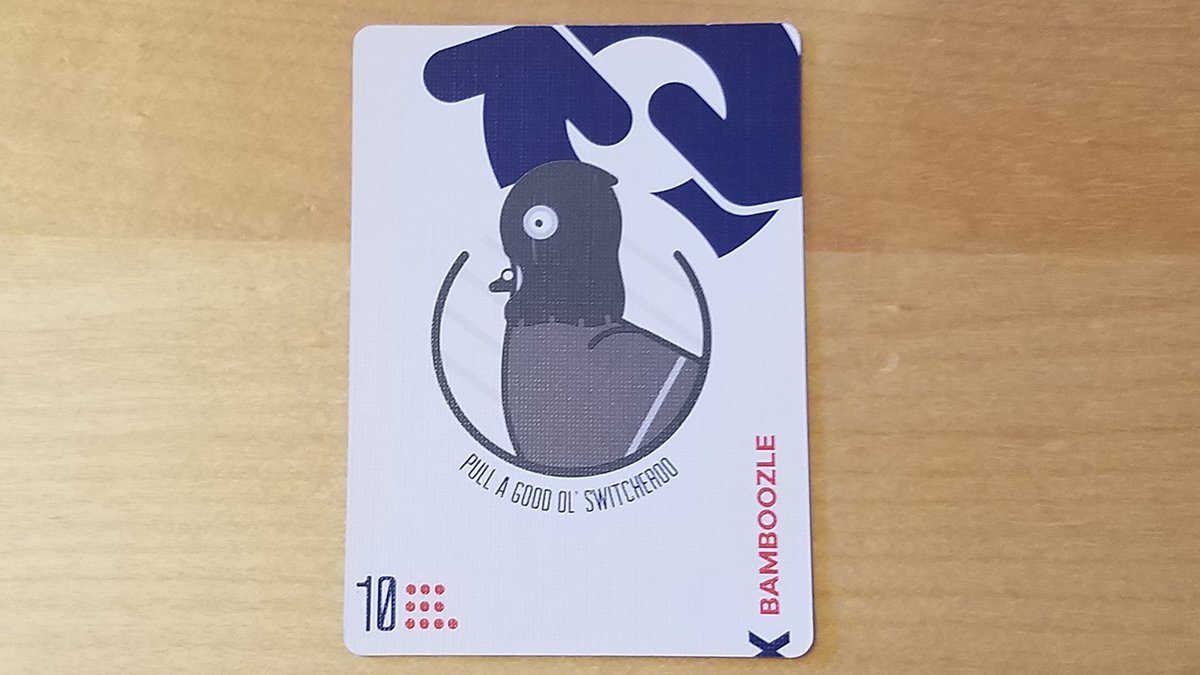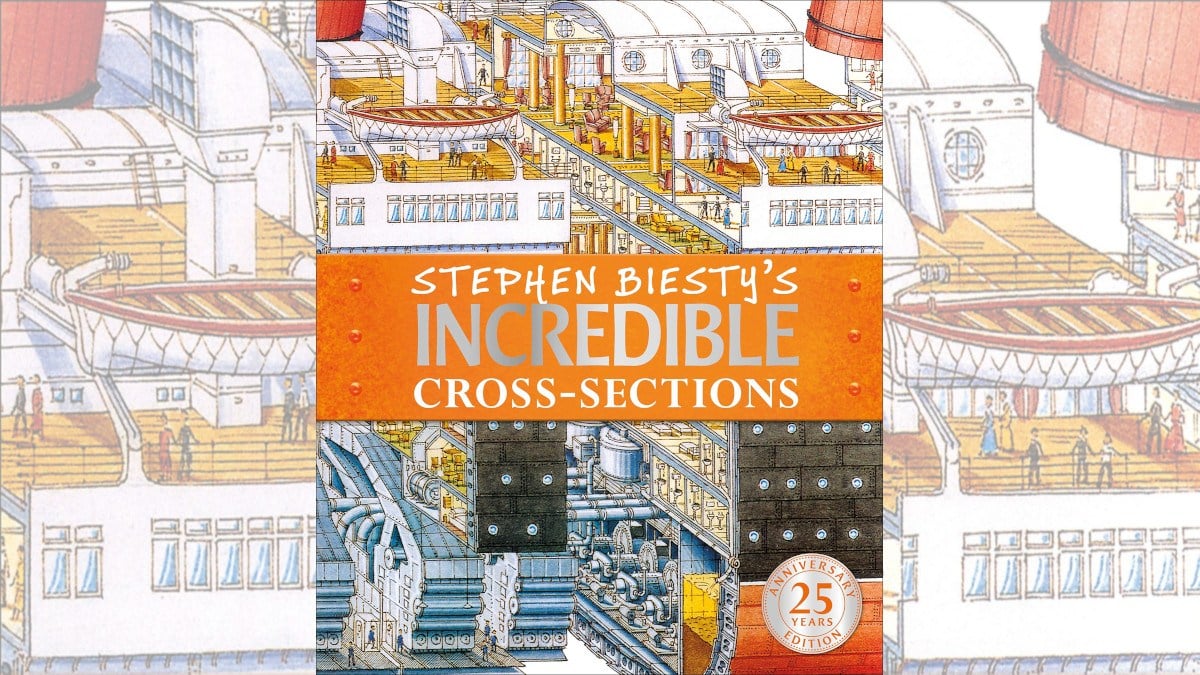
What Is Stool Pigeon?
Stool Pigeon is a game for 2-6 players, ages 12 and up, and takes about 10 minutes to play. It’s currently available at Amazon and other fine retailers. Amazon charges $19 for a copy of the game.

Stool Pigeon Components
Stool Pigeon is simply a card game, so the box contains only:

- 56 cards
- A rulebook
The cards are plastic coated poker-sized cards.

The artwork on most of the cards is straight-forward: a large number for the card’s value, along with a set of dots also representing that value, and a small pigeon. Any game that is going to use numbers on cards has to figure out how to deal with making sure players aren’t confused by the 6 and the 9. Stool Pigeon handles this in two subtle yet beautiful ways. First, as can be seen in the image above, every number card has two stripes in the bottom right corner, letting you know which way is up.

But even better is the use of the pigeon. The artist here drew the pigeon sitting on the numbers, providing a second way to identify the difference between them. It’s such an elegant design solution to a common problem, and one the game’s designers deserve a lot of credit for.

There are also six special cards. Each of these confer a special power when played, which I’ll discuss later. Design-wise, these are very different from the number cards so there’s no chance you’ll mistake them. Each has a large central picture and a small amount of descriptive text, plus the card’s point value.
How to Play Stool Pigeon
The box for Stool Pigeon says, “learn in five minutes, play in seven.” Both of those statements are broadly true.
The Goal
The goal of the game is simple: have the lowest point total (sum of the values of your cards) at the end of the game.
Setup

Shuffle the deck, then deal four cards, facedown, to each player, creating each player’s hand (even though they won’t ever hold them in their hand). Put the rest of the deck in the middle of the table, and you’re ready to go.
Gameplay
At the beginning of the game, everyone points, on the count of three, to the player they feel looks the shiftiest. That player goes first.
Before the first player’s turn, everyone is allowed to look at two, and only two, of their facedown cards, or hand. Part of Stool Pigeon is a memory game—you need to keep track of the cards you have so you know your point total and can decide when to bring the game to a close.
The first player draws the top card off the deck. This first time, there’s not much to do. If the card they drew is a number card, they can swap it with any card from their hand. Obviously, if the card is lower than one of the two cards they looked at, they’ll swap that out. Otherwise, it’s a bit of a blind guess on the two hidden cards.
If the card they drew is an action card—one of five of the six special cards—then they can choose to either swap the card with one of their own, or they can play the card’s action.
Either way, they will end up discarding something—the action card or one of their starting cards.
At this point, one of the other players may be able to stack. If they have a card in their hand that exactly matches the card the player just discarded, then they can also discard their card, leaving them with only three cards. Because the goal of the game is to end with the smallest possible total, obviously having fewer cards is generally a good thing. However, only the fastest player can stack. If two or more players happen to have a matching card, whoever gets their card down on the discard pile first wins. The others have to return their card to its place in front of them.
Oh, and two other important rules: throughout the game, you’re only allowed to use one hand. And, except for that point right before the first turn, you cannot look at the cards in front of you unless another card allows you to. So no checking to see which card you think matches the discard. You simply need to play… but if you’re wrong, you not only take back your card but also have to draw another card as a penalty.
If either no one tries to stack, or once someone does it successfully, the next player goes. However, from this point on, everyone has another choice: rather than drawing the top card from the draw pile, they can instead choose to draw the top card off the discard pile. So, if the player before you swapped a card and discarded a low card, you can choose to grab that and swap it for one of your high-point cards.
The game continues like this until someone decides to end it. See the section below on “Game End” for details, but first, I want to describe those six special cards and what they do.
Special Cards

Meatball: This is the one special card that doesn’t grant any additional abilities. It’s simply a number card, but it’s a good one: to quote the card itself, “a big fat zero, baby.” There’s only one of these in the deck, so if you manage to get hold of it, you want to do what you can to keep it.

Kingpin: The Kingpin card counts as a 1, so it’s good to just get and hold on to. But, it also has a special power that may make it worth playing rather than holding: when you play this card, you can either add or eliminate a card currently in play. To eliminate a card, you simply remove any card from any hand on the table. Most of the time, of course, you’re going to use it to get rid of a high-point card in your hand. When you do this, you’ll be playing with one less card for the rest of the game.
Your other option with Kingpin is to add a card, whereby you draw the top card from the deck and add it to someone’s hand. This does mean they would have more than four cards, and in fact, because there are multiple Kingpins and the possibility of penalties, an unfortunate player could, in theory, end up with almost an unlimited number of cards.

Bamboozle: This card is worth 10 points, so it’s not one you generally want to keep around. But its power is pretty cool: when you play it, you can swap any two cards on the table. So if you know you have another high-value card, you can swap it with someone else’s card, which if you’ve been paying attention you might already know is a low-point card. Or, if you just want to mess with your friends, you can swap their cards around. This can be good to remove cards that someone knows from in front of them by giving them a blind card from another hand.

Stool Pigeon: Like Bamboozle, Stool Pigeon is worth 10 points, so you will almost always want to play its power, which is simple: “Take a peek at any card.” As with all of the other special cards, it really is any card, so you can use it to see one of the cards you have that you haven’t looked at it, or you can look at an opponent’s cards so that you know what you want to Bamboozle later.

Vendetta: Another 10-point card that basically combines the powers of Stool Pigeon and Bamboozle. With Vendetta, you can look at any card on the table, and then swap any two cards. A key point here: the card you peek at does not have to be one of the ones you swap. It obviously will be if you look at an opponent’s card and see that it’s a lower point card than one you have, but you might choose to take the opportunity to learn more about your hand, and then swap two opponent’s cards to mess with them.

Rat: Rat is a particularly onerous card. For starters, it cannot be discarded. For example, let’s say that you have Rat in your hand but don’t know it’s there. You draw a number card and try to swap the number card for Rat. Sorry! Because you can’t discard Rat, you have to keep it, but you also get to keep the card you just drew. Bummer.
But if you have Rat, you aren’t necessarily stuck with it. You can certainly gift it to someone by using Bamboozle or Vendetta to swap it with an opponent’s card, but you can also use Kingpin to simply get rid of it.
Rat also doesn’t have a specific point value. Instead, if you still have Rat in your hand at game’s end, you draw the next card off the deck and apply that card’s points to your total.
The good news: there’s only one Rat.
Game End
The game ends when a player knocks. It’s a literal knock on the table. At that point, everyone else gets one final turn, and then all cards are revealed, everyone totals their points, and you find out who won.
Knocking is your entire turn. You cannot draw a card or swap or do anything else.
This is an interesting component to the game because it’s impossible to tell exactly when someone might knock. In one game we played, I was able to determine by the second round that three of my cards were very low: I had the Meatball, a Kingpin, and a 2, which would total only 3 points. I was seriously tempted to knock on only my third turn, figuring that even if that hidden card was a 10 (which, statistically, it was likely to be), my 13 points were likely to beat anyone else’s point total as we all still had 4 cards. However, before I could do that, my wife played a Bamboozle card and swapped one of her cards with, as luck would have it, the Meatball. No longer assured of my victory, I decided to keep playing (and eventually lost).
But not knocking has limitations as well: if someone else knocks, you have to take another turn. But if you have four low cards and didn’t knock, then on your last turn you have to draw a card and play it. And if that card is higher than one of your existing cards, well, too bad. You have to swap it for one of your cards, even though it increases your score.
There is one scenario where a player must knock: if they are down to zero cards. Again, through both stacking and playing the Kingpin, it’s possible to eliminate your cards, so on your next turn, you have to knock. But, you aren’t guaranteed a zero-point easy win, because remember everyone else still gets to play one last turn, and any of them could get a Kingpin and use it to give you cards. If that happens, you’re just out of luck, because you cannot take back a knock once it happens.
Why You Should Play Stool Pigeon
My son and I first encountered Stool Pigeon at Kubla Con, where we met two of the designers, who showed us the basics of the game. My son was immediately taken by it, so I asked for a review copy so that we could explore the game further. We pulled the game out at dinner and played it again and it very quickly became clear it would become a favorite.
A few weeks later, my parents came to visit for the end of the school year, and it was one of the first games we pulled out to show them. My mom admitted that she didn’t fully understand the game when we played it the first time (a game my son easily won, which would become something of a pattern). Very often, mom is quick to get frustrated with games that I do a bad job of explaining, but this time, her reaction was very different: the game was intriguing enough that she didn’t want to give up on it.
Over the weekend, we played a lot of games, but none more than Stool Pigeon. Yes, it helps that games only last a few minutes, but there were other fast games that made it to the table over the weekend that didn’t get replayed over and over.
Part of the game’s charm is that it’s fun and silly, but also, there is a real strategic element to it. From the very first moment of deciding which two cards to look at, to choosing when to draw the top card from the deck blind to picking the known card on top of the discards, right down to deciding when the end the game, there are lots and lots of decisions players need to make. While, as a card game, there’s still a lot of luck involved, this game doesn’t feel like it’s won and lost based on whether or not you managed to draw just the right card at the right moment.
There is also a “gotcha” element in the game, with the special cards allowing you to swap your opponents’ cards, but with everything happening as fast as it does, you don’t really have a chance to mull over how badly you may have just been screwed, and besides, there’s a good chance you’ll be able to get even within a turn or two.
When I first got that demo of the game, I figured I would enjoy Stool Pigeon. I didn’t expect it to quickly become one of my favorite games of the year. I have no doubt that I will be playing this game a whole lot down the road. In fact, I may need to go ahead and buy another set, since my son wants to take it to summer camp because he’s sure his fellow Scouts will like it, but that means there will be two weeks this summer where I don’t have a copy at home, and I’m not sure I’m okay with that.
Click here to see all our tabletop game reviews.

To subscribe to GeekDad’s tabletop gaming coverage, please copy this link and add it to your RSS reader.
Disclosure: GeekDad received a copy of this game for review purposes.




